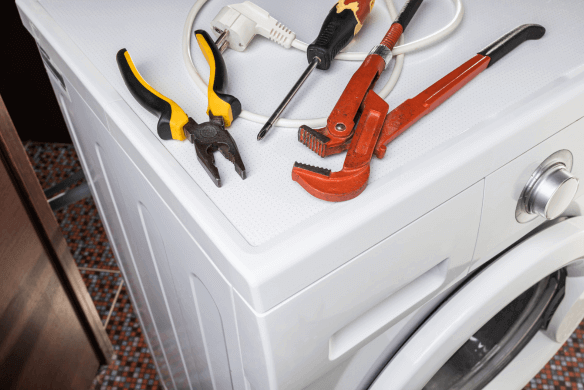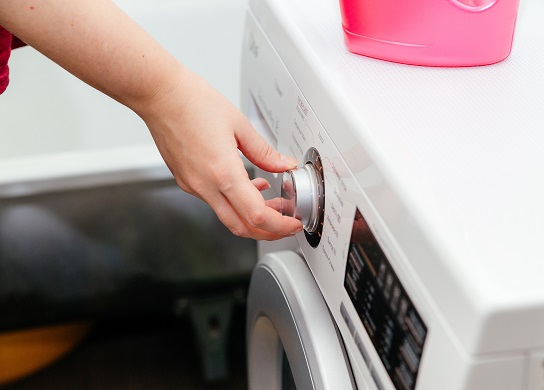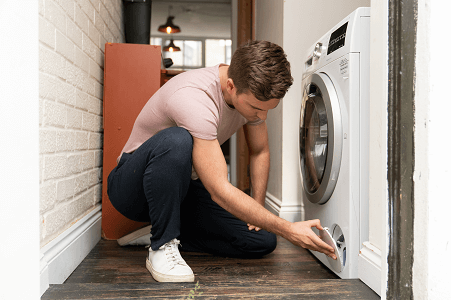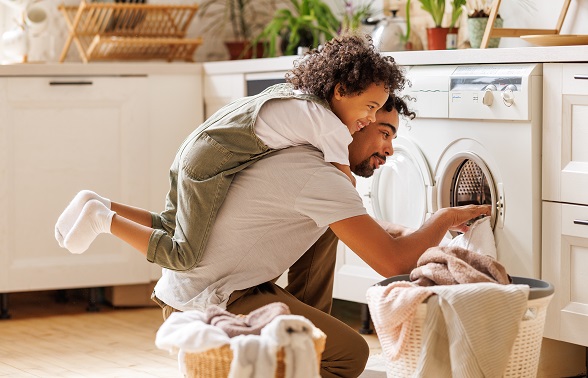When you buy a washing machine, the supplier might offer to install it for a fee. But there’s also the option of doing it yourself to save money.
Put your safety first
You don’t need technical skill to install a washing machine, but they are big and heavy. So first of all, make sure you can handle it without hurting yourself. It’s also a good idea to have another adult nearby in case you need help. Be careful to:
- Lift or move the washing machine properly to avoid injury
- Use gloves that protect your hands and help you grip
- Wear steel-toed boots to save your feet if the appliance falls
Getting ready to install your washing machine
Check where to install it
If you’re installing the washing machine somewhere new, you’ll need to check the room has the right connections. These are:
- Water: most modern washing machines only need cold water, but some older or top-loading machines might need hot as well
- Waste: this hose needs to connect to a waste pipe or trap at a height above the top of its drum, or be held up with a U-shaped bracket
- Electrical: a standard plug socket close enough for the washing machine’s cable to reach
Also be aware that in uninsulated areas like garages, water pipes and hoses can freeze in winter. So it’s best to keep your washing machine somewhere warmer.
And don’t forget to measure the space to make sure the washing machine will fit.
Gather what you’ll need

You won’t need much equipment. Just have these to hand:
- Your washing machine, with its hoses
- Grippy gloves (if the threaded parts are hard to turn)
- A spirit level
If you’ll attach the drain hose to a sink which hasn’t been connected before, you’ll also need:
- A hacksaw or similar cutting tool
- A metal hose clip (sometimes called a Jubilee clip)
Remove the transit bolts
New washing machines come with bolts that prevent damage while they’re being delivered. You have to remove these bolts by unscrewing them at the back of the machine. Most washing machines come with a small spanner for this purpose. And remember to keep the bolts, as you’ll need them if you take it to a new house.
How to plumb in a new washing machine
Once you’ve found the spot for your washing machine and have the tools to hand, you’re ready to start.
Do you have Domestic & General cover?

If we’re replacing your washing machine under your Domestic & General plan or policy, check whether installation is included. That could save you the hassle of doing it yourself. To find out more, see our guide to how we replace products that can’t be fixed.
1. Check the position
Before you attach the washing machine’s hoses, move it to its final position to check it fits. Do this by sliding or nudging the machine little by little. Have another adult there to help and be careful not to scratch your floors.
When the machine is where you want it, put a spirit level on top. If the machine isn’t level, you can adjust the feet at the front. With someone else’s help, tilt the front of the machine up to reach the feet underneath. They can usually be adjusted by hand, turning anti-clockwise to lower and clockwise to raise.
2. Attach the cold water pipe

Now pull the machine out of the space again, so you can attach the hoses to the wall. Most modern washing machines only need to take cold water in. But if you have an older machine or a top-loader, it might need a hot water connection as well. If you’re unsure, check your manual.
New washing machines usually come with the cold water hose stored inside the drum. Take it out and screw it onto the threaded plastic connection on the back of the machine. It only needs to be tightened by hand – you can use grippy gloves if that helps. But avoid over-tightening as that can damage the parts.
Next attach the other end of the hose to the cold water pipe on the wall. The valve often has a blue part to show that it’s cold. Again, just tighten this by hand.
3. Connect the waste pipe to the drain

Most washing machines come with the drain hose already attached to the back. It’s usually a long, grey hose.
Some machines also come with a U-shaped bracket. This is for hanging the drain hose up, which stops dirty water going back into the machine. Put the hose on the bracket before you attach it to the wall or other surface (as it will be difficult afterwards). If drilling, you’ll need tools like a wall scanner to avoid electrical cables in the wall, a drill with the right bit, a screw and a wall plug. Typically the hose’s highest point needs to be 65cm to 100cm above the floor. Have a look for details in your user manual.
There are a few ways your drain hose can be connected:
- To the sink’s downpipe
- To an open-topped vertical pipe called a standpipe
- Hanging over a sink or basin
If you’re connecting to the sink’s downpipe, you’ll see a tapered plastic part which comes off at a right angle. Cut the tip off this part if it hasn’t been done already. Use a saw to remove about two centimetres from the thin end. Then fit the drain hose into that opening and secure it with a metal hose clip (Jubilee clip).
Or if the hose will go into a vertical standpipe, simply push the hose into that pipe. Check it can’t touch the bottom though – that could make the drain overflow or stop water draining.
For hanging the drain hose over a sink or basin, you need the U-shaped bracket that came with the hose. Attach that to the wall or another surface (usually 65cm to 100cm from the floor), checking it won’t get shaken off by vibration. Then make sure there’s a gap between the end of the hose and what it empties into. Otherwise, the hose can pull dirty water back into the machine.
4. Plug in and switch the machine on

Now you can plug in the machine and push it back towards the wall. Be careful to leave room behind so the hoses aren’t crushed.
It’s worth checking the machine is still level – use the spirit level and readjust the feet if needed.
Finally, give your washing machine a test spin. It’s better to catch any leaks now before they can cause a problem. So if you see water on the floor, find where it’s coming from. It might be a connection that needs tightening, or a hose that needs replacing.
Contact us for more help
If you run into trouble while installing your washing machine, our network of expert engineers is ready to help. It’s easy to book online and you don’t need a Domestic & General plan.
Our blog is loaded with more related articles

Washing machine tips
How to disconnect your washing machine
Read our comprehensive guide for step-by-step instructions on how to safely disconnect your washing machine, tumble dryer and o...
Read more

Washing machine tips
How to extend the lifespan of your washing machine
The humble washing machine is the workhorse of a household. By following some simple hints and tricks you could add a few more...
Read more

Washing machine tips
Save energy and the planet with your laundry habits
When it comes to washing and drying our clothes, striking the right balance between cutting costs, conserving energy, and savin...
Read more
